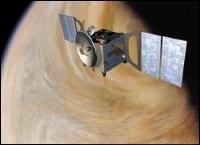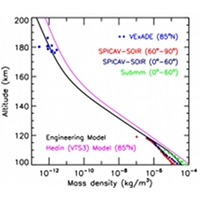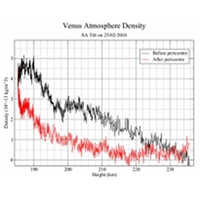Venus Express probes the planet's atmosphere by flying through it
7 October 2010
ESA's Venus Express is exploring the density of the Venusian upper atmosphere by measuring how much the planet's atmosphere itself slows down or twists the pointing of the spacecraft. New density measurements, centred on the Northern Pole and obtained during these atmospheric drag experiments, show an unexpected inhomogeneous pattern in the atmosphere of our neighbouring planet. These latest results from the Venus Express Atmospheric Drag Experiment are being presented, this week, at the 42nd annual meeting of the Division for Planetary Sciences of the American Astronomical Society held in Pasadena, California. |
| Illustration of Venus Express. Credit: ESA |
In orbit around Venus since 2006, the Venus Express spacecraft has been monitoring the atmosphere of our neighbouring planet with a broad suite of instruments. Although none of these instruments can directly collect and analyse samples of atmospheric gas, two techniques have been developed to perform in-situ measurements of the density of the Venusian atmosphere by making use of the whole spacecraft as a laboratory.
One of the methods exploits the drag effect that the Venus Express spacecraft experiences while moving through the planet's atmosphere. In fact, the atmosphere slows the spacecraft down, slightly altering its trajectory, and by measuring this effect it is possible to estimate the atmospheric density. This is the concept lying behind the Venus Express Atmospheric Drag Experiment (VExADE) which has been running as a series of measurement campaigns since 2008. VExADE yields local measurements of the density, in contrast to the remote measurements obtained by the onboard instruments.
"The drag effect represents a unique opportunity to perform in-situ measurements of Venus' atmospheric density," explains Håkan Svedhem, Venus Express Project Scientist. "Moreover, drag measurements probe the upper level of the atmosphere, about 180 kilometres above the surface, a region that is inaccessible to remote sensing observations which only target lower layers, at 140 kilometres and below," he adds. Along with the other instruments on board Venus Express, the atmospheric drag campaigns contribute to the creation of a complete picture of the planet's atmosphere.
| Measuring the torque experienced by the spacecraft yields an estimate of the atmospheric density. (Click here for a larger animation and further details.) Credit: ESA |
Another technique, which has been tested earlier this year and employed in the latest VExADE campaign, was proposed by the Flight Dynamics team at ESOC led by Michael Mueller and Mathias Lauer. It is based on an asymmetric configuration of Venus Express's solar panels: positioned with an angle of 90 degrees between each other, one of the panels is perpendicular to the incoming flow, whereas the other sees it edge on. In this arrangement, the spacecraft experiences a torque moment, or twisting force: as the atmosphere causes it to turn, the internal reaction wheels compensate for the twist, keeping the spacecraft at the right attitude - in other words, they keep it pointed in the right direction. The torque is not directly observed, but it is recorded by the on board instrumentation and translated into an estimate of the density of the atmosphere.
"By monitoring the torque exerted by the atmosphere on Venus Express, we can achieve density measurements with unprecedented sensitivity. Instead of measuring only an average value, we can now reconstruct the altitude density profile of the entire segment of atmosphere through which the spacecraft is flying," explains Svedhem.
| Atmospheric drag induces orbital perturbations as shown in this animation. (Click here for a larger animation and further details.) Credit: Royal Observatory of Belgium |
Drag campaigns are possible thanks to Venus Express's highly eccentric orbit, which has an apocentre distance of about 66,000 kilometres, but gets as close as 250 kilometres to the planet's surface when at pericentre. It is around the pericentre that the spacecraft starts to dip into the atmosphere and experience a drag effect. However, at an altitude of 250 kilometres the atmosphere is not dense enough to produce a significant, and thus measurable effect. In order to perform the measurements, the pericentre is lowered, for a few days, to an altitude below 200 kilometres, where the denser atmosphere produces a more significant effect, and then it is raised again.
"When Venus Express is close to pericentre, it experiences the drag for about 6 minutes," says Pascal Rosenblatt from the Royal Observatory of Belgium, who led the effort to measure the atmospheric density during the VExADE campaigns. "During the campaigns, which last for a few consecutive days, extensive radio tracking of the spacecraft is performed, in order to reconstruct its orbit as precisely as possible and to disentangle the drag effect from gravitational effects and other forces," he explains.
Venus Express has a polar orbit with its pericentre almost precisely above the planet's North Pole, hence its drag measurements provide a direct estimate of the atmospheric density in this region. Previous in-situ measurements of Venus' atmosphere, conducted in the 1980s and 1990s by the Pioneer Venus Orbiter (PVO) and the Magellan missions, focussed on the equatorial regions, instead. The extensive data from PVO and Magellan have been used to construct models for the upper atmosphere of Venus which are now challenged by the latest measurements obtained by Venus Express at the North Pole.
"The value we measured is significantly lower than expected, by about 60 per cent," says VExADE team leader Ingo Mueller-Wodarg from Imperial College, London. The existing models, however, rely on previous data and predict the polar atmospheric density from the values measured at equatorial latitudes, assuming a symmetry with solar zenith angle. "The discrepancy shows that the simple, symmetric assumption underlying these models is not entirely correct, and that the behaviour of Venus' atmosphere at this altitude at the North Pole is different from that at the Equator," adds Mueller-Wodarg. The reason for such a discrepancy is still unclear, although it is suspected that winds might play a significant role. An additional factor may be due to the fact that the Sun was very active during the Pioneer Venus measurements, whereas VExADE has been conducted during a period of low solar activity.
The two methods, focussing respectively on the drag and torque imprinted by the atmosphere on Venus Express, represent two independent techniques to probe the atmospheric density of the planet. "The agreement between the measurements achieved via the two different methods is an outstanding result," comments Svedhem.
In order to acquire the scientific data in a safe way, atmospheric drag campaigns have to be executed in an operationally cautious manner. Once the spacecraft is low enough to experience drag, safety considerations come into play. "We have to understand the effects on the spacecraft stability or the change in thermal heat caused by its interaction with the atmosphere, and whether it is necessary to prepare contingency escape manoeuvres," explains Octavio Camino, Venus Express Spacecraft Operations Manager.
The operations team need to know how low they can safely take the spacecraft. Using the reaction wheels to measure torques has been demonstrated to be a fast, accurate and reliable approach in the upper layers of the atmosphere. This will, however, not be sufficient if Venus Express ever tries to fly deeper into the atmosphere. "At the moment we have just begun to approach the dense layers of the atmosphere and to have a first sense of the conditions there. It is a careful, step-wise procedure: every day's measurements help us in planning our next move," adds Camino.
The new procedures implemented by the operations team are extremely helpful in developing expertise in light of future aerobraking manoeuvres - a complex procedure employing the planet's atmosphere to modify the spacecraft's orbit - as ESA is investigating the possibility to conduct such operations at Venus in the future.
Contacts:
Pascal Rosenblatt
Royal Observatory of Belgium (ROB)
Phone: +32 2 373 67 30
Email: pascal.rosenblatt oma.be
oma.be
Ingo Mueller-Wodarg, Reader in Planetary Science
Imperial College London, UK
Phone: +44 7973 271 816
Email: i.mueller-wodarg imperial.ac.uk
imperial.ac.uk
Håkan Svedhem, Venus Express Project Scientist
Directorate of Science & Robotic Exploration, ESA, The Netherlands
Phone: +31 71 565 3380
Email: hsvedhem rssd.esa.int
rssd.esa.int
Octavio Camino, Venus Express Spacecraft Operations Manager
European Space Operations Centre, ESA, Germany
Phone: +49 6151 902799
Email: Octavio.Camino esa.int
esa.int





